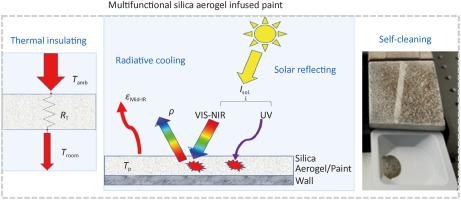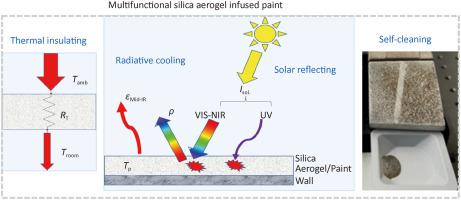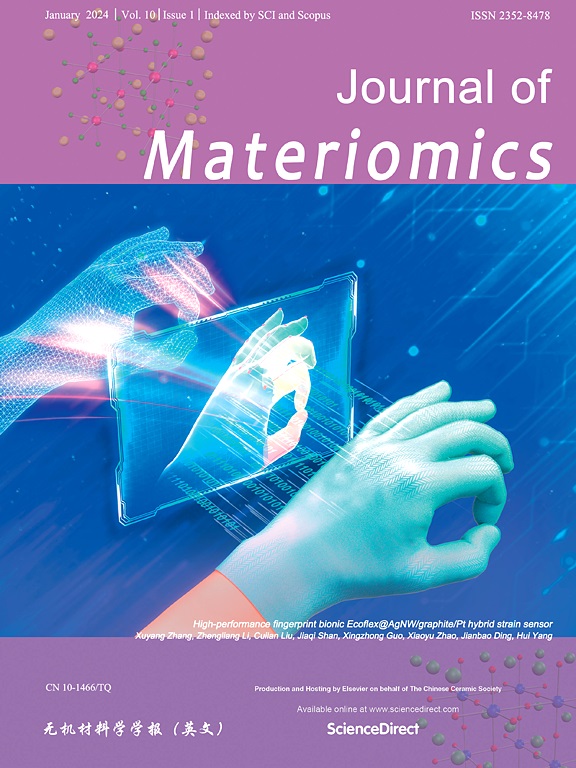Multifunctional silica aerogel-infused paint for self-cleaning and radiative cooling
IF 9.6
1区 材料科学
Q1 CHEMISTRY, PHYSICAL
引用次数: 0
Abstract
Massive energy is consumed to cool buildings for comfortable life in hot climates due to indoor air-conditioning, which necessitates the passive daytime radiative cooling of buildings. Given the high ambient temperature, it is essential to increase the thermal resistance of building walls through paints and enhance their durability to dust and aerosol contamination. In this work, a multifunctional composite paint, mainly consisting of inorganic pigments and mesoporous silica aerogel (SA), is proposed for passive radiative cooling, low thermal conductivity, and surface self-cleaning. In comparison with ordinary paint, the SA microparticles-infused composite paint can enhance the reflectance (ρVIS-NIR) to the solar irradiance by up to 15% in the visible and near-infrared ranges (0.3–2.5 μm). It also maintains the radiative cooling property with about 0.96 emissivity (εLWIR) in the atmospheric transparency windows (8–13 μm) for thermal radiation to dissipate into the cold outer space. Even after long-term outdoor exposure to harsh environmental conditions, SA-infused white paint can still maintain its spectral and wetting properties, achieving daytime cooling with 7.4 °C lower than the ambient temperature. Moreover, the SA infusion enables the paint to reduce the thermal conductivity by 50% and provide much better thermal insulation, while SA renders the paint surface hydrophobic and self-cleaning.


多功能二氧化硅气凝胶注入涂料自清洁和辐射冷却
在炎热的气候条件下,由于室内空调的存在,需要消耗大量的能量来冷却建筑物,以满足人们舒适的生活,这就需要建筑物在白天进行被动辐射冷却。鉴于环境温度高,必须通过涂料增加建筑墙壁的耐热性,并提高其对灰尘和气溶胶污染的耐久性。本文提出了一种多功能复合涂料,主要由无机颜料和介孔二氧化硅气凝胶(SA)组成,具有被动辐射冷却、低导热和表面自清洁功能。与普通涂料相比,添加SA微粒的复合涂料在可见光和近红外波段(0.3 ~ 2.5 μm)对太阳辐射的反射率(ρVIS-NIR)提高了15%。在大气透明窗(8 ~ 13 μm)范围内,其发射率(εLWIR)保持在0.96左右,使热辐射散发到寒冷的外层空间。即使长期暴露在室外恶劣的环境条件下,sa注入的白色涂料仍然可以保持其光谱和润湿性能,实现比环境温度低7.4°C的日间冷却。此外,SA的注入使涂料的导热系数降低50%,并提供更好的隔热,同时SA使涂料表面疏水和自清洁。
本文章由计算机程序翻译,如有差异,请以英文原文为准。
求助全文
约1分钟内获得全文
求助全文
来源期刊

Journal of Materiomics
Materials Science-Metals and Alloys
CiteScore
14.30
自引率
6.40%
发文量
331
审稿时长
37 days
期刊介绍:
The Journal of Materiomics is a peer-reviewed open-access journal that aims to serve as a forum for the continuous dissemination of research within the field of materials science. It particularly emphasizes systematic studies on the relationships between composition, processing, structure, property, and performance of advanced materials. The journal is supported by the Chinese Ceramic Society and is indexed in SCIE and Scopus. It is commonly referred to as J Materiomics.
 求助内容:
求助内容: 应助结果提醒方式:
应助结果提醒方式:


